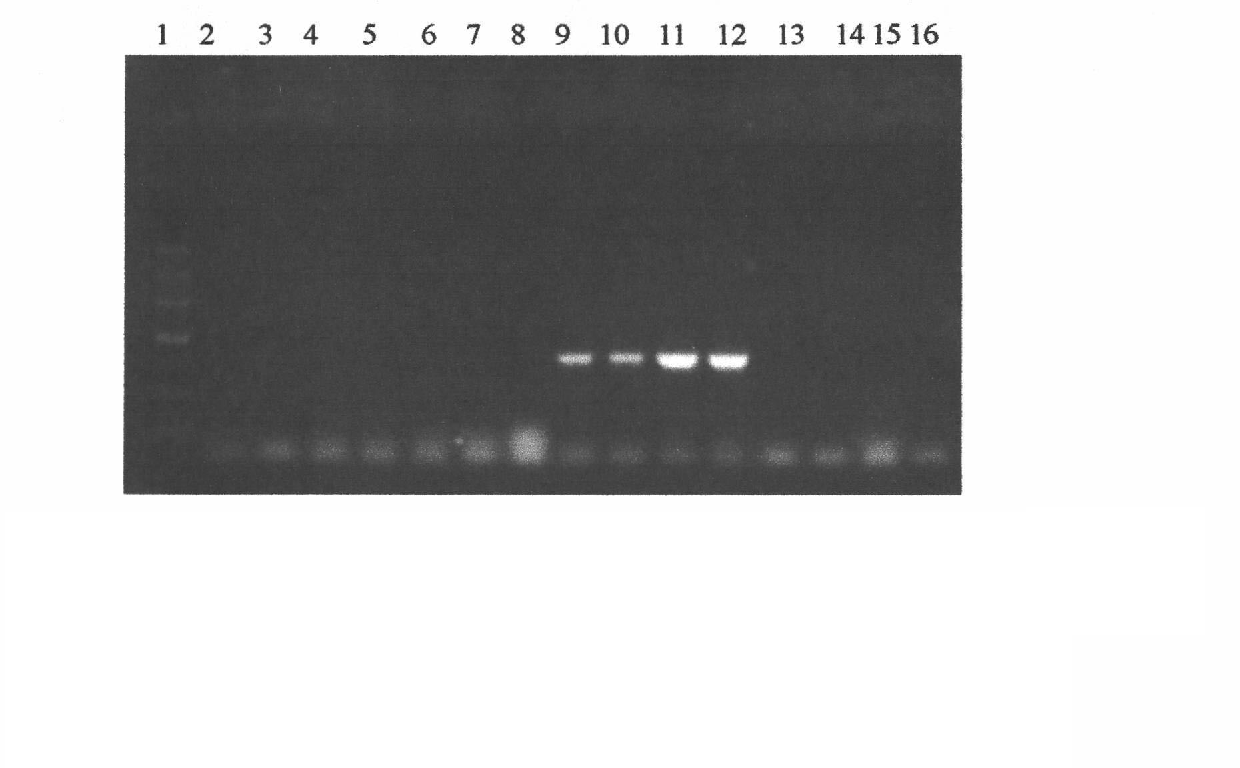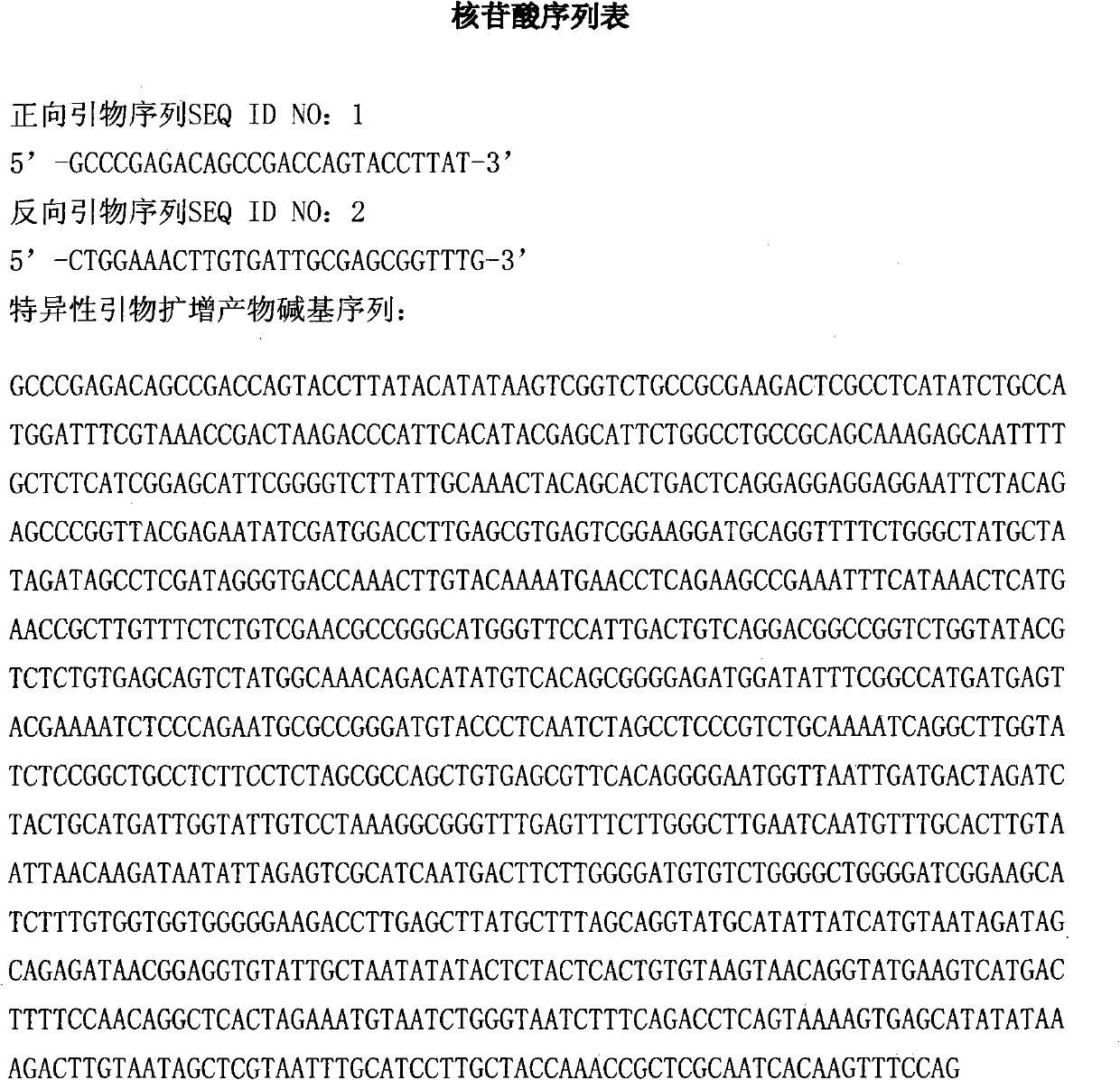Method for identifying Epidermophyton floccosum of rabbit
A technology of Epidermophyton floccosum and rabbits, which is applied in the field of molecular biology and can solve the problems of high cost, difficulty in popularization and application, and high requirements for operators.
- Summary
- Abstract
- Description
- Claims
- Application Information
AI Technical Summary
Problems solved by technology
Method used
Image
Examples
Embodiment 1
[0022] Add 0.05-0.1g of ground mycelium sample to 1mL urea extract (7mol / L Urea, 50mmol / L Tris-HCl pH 8.0, 62.5mmol / LNaCl, 1% SDS), shake well, centrifuge at 12000r / min for 5min, draw The supernatant was centrifuged again at 12000r / min for 5min; the supernatant was transferred to another new tube, and an equal volume of phenol: chloroform: isoamyl alcohol (25:24:1) solution was added, and the mixture was shaken vigorously several times. Mix well, centrifuge at 12000r / min for 5min; take the supernatant into a new tube, add an equal volume of isopropanol and 1 / 10 volume of 3mol / L NaAc (pH 5.2), place at -20°C for 30min, centrifuge at 12000r / min for 15min; discard Invert the supernatant to drain the liquid from the tube wall, wash the precipitate with 70% absolute ethanol, let it dry at room temperature for 30 minutes, dissolve it in 50ul double-distilled water, and store it at -20°C for later use.
[0023] Specific primer pair: artificially synthesized forward primer sequence SE...
Embodiment 2
[0031] Inoculate the mycelium of the above-mentioned bacterial strains on fungal selective agar medium (soytone 1%, glucose 4%, agar 1.8%, chloramphenicol 0.005%, cycloheximide 0.05%) in 150ml fungal selective liquid culture base, cultivated at 28°C for 10-15 days, picked mycelium in a mortar, ground it with liquid nitrogen, put 0.05-0.1 g of ground mycelium in a 1.5ml Eppendorf tube, and extracted genomic DNA. The specific operation is as follows:
[0032] 0.05-0.1g ground mycelium sample (100mmol / L Tris-HCl pH9.0, 40mmol / L EDTA pH8.0), shake and mix well, add / add 100μL 10% SDS, 300μL benzyl chloride, shake vigorously, Make the mixture in the tube milky, keep warm at 50°C for 1 hour, oscillate and mix once every few minutes, cool to room temperature, add 300 μL pre-cooled 3mol / L NaAc (pH5.2) solution, mix well, then ice bath for 15 minutes, 11000r / Centrifuge for 15 min; take the supernatant, add an equal volume of chloroform:isoamyl alcohol (24:1), mix well, and centrifuge a...
Embodiment 3
[0042] Trichophyton mentagrophytes standard bacterial strains are inoculated in 150ml mycelia of fungal selective agar medium (soytone 1%, glucose 4%, agar 1.8%, chloramphenicol 0.005%, cycloheximide 0.05%) Fungal selective liquid medium, cultivated at 28°C for 10-15 days, pick mycelia in a mortar, grind with liquid nitrogen, put 0.05-0.1g of ground mycelium in a 1.5ml Eppendorf tube, and use chlorination Genomic DNA was extracted by the benzyl method, and the clinical wool samples were extracted by the benzyl chloride method. The specific operations are as follows:
[0043] 0.05-0.1g ground mycelium sample, 0.01-0.1g rabbit skin hair sample (100mmol / L Tris-HCl pH9.0, 40mmol / L EDTA pH8.0), shake and mix, add 100μL 10% SDS, 300 μL of benzyl chloride, shake vigorously to make the mixture in the tube milky, incubate at 50°C for 1 hour, shake and mix once every few minutes, cool to room temperature, add 300 μL pre-cooled 3mol / L NaAc (pH5.2) solution, mix well , then ice-bathed fo...
PUM
 Login to View More
Login to View More Abstract
Description
Claims
Application Information
 Login to View More
Login to View More - R&D
- Intellectual Property
- Life Sciences
- Materials
- Tech Scout
- Unparalleled Data Quality
- Higher Quality Content
- 60% Fewer Hallucinations
Browse by: Latest US Patents, China's latest patents, Technical Efficacy Thesaurus, Application Domain, Technology Topic, Popular Technical Reports.
© 2025 PatSnap. All rights reserved.Legal|Privacy policy|Modern Slavery Act Transparency Statement|Sitemap|About US| Contact US: help@patsnap.com


